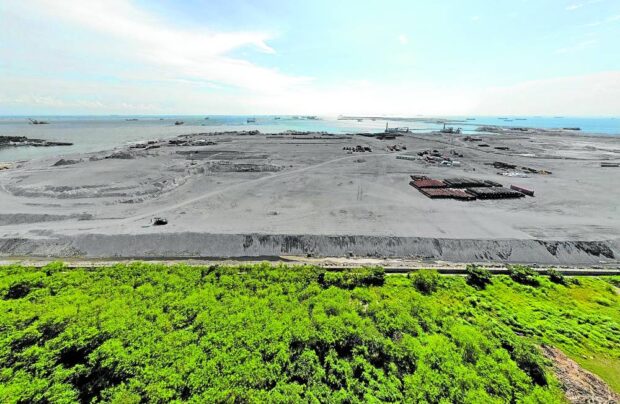
LAND AHOY! The reclamation site in Manila Bay along Diokno Boulevard in Pasay City looks desolate on Monday, Aug. 14, 2023, after the government suspended all reclamation activities in the bay. (Photo by GRIG C. MONTEGRANDE / Philippine Daily Inquirer)
MANILA, Philippines — The respite from reclamation activities in Manila Bay could give the country’s engineers and marine scientists time to study and design coastal engineering solutions that could mitigate its adverse impacts, according to experts advocating for stronger policies to improve coastal resilience in the country.
Speaking to reporters on Monday, Philippine Council for Industry, Energy and Emerging Technology Research and Development (PCIEERD) head Enrico Paringit and University of the Philippines (UP) geologist Fernando Siringan said it was even more urgent to improve the country’s coastal management policies amid the threats of reclamation and rapid urban development.
This includes, among others, designing proper interventions that could protect coastal communities from erosion and flooding; and studying how projects like dump-and-fills affect coastal areas like Manila Bay, they said.
“We do not really exclude the possibility that these developments might even work for us especially since we’re constrained in terms of resources,” Paringit said.
“But we need to take a look at scientific merits of having them constructed, what are their pros and cons, what can make it successful and what could threaten it, what are its unintended consequences,” he added.
‘We wait first’
So “until such time that you have a clear idea of what is being lost and whether it can be recovered, or whether technology can be used to minimize impacts, then it’s only right that we wait first,” Siringan said.
Siringan was referring to President Ferdinand Marcos Jr.’s order to suspend all 22 reclamation activities in Manila Bay to review how these projects would impact its ecosystems.
This developed as the PCIEERD led a coastal resilience summit hosted by Mariano Marcos State University (MMSU) in Batac, Ilocos Norte province to discuss different experiences and projects both here and abroad in improving coastal resilience.
Many advocates consider Manila Bay as the poster child of coastal management challenges, with reclamation and seabed mining drastically changing its landscape and ecosystems.
But “what is happening in Manila is happening across the country,” Paringit said, as sea level rise and coastal erosion happen at varying degrees across the country.
Coastal engineering
At least 60 percent of the country’s population live in coastal communities, leaving them vulnerable to these climate change-related impacts.
“And while not everyone will suffer severe problems, they will likely experience one or few types of coastal hazards and suffer long-term events,” Paringit added.
These challenges are also why the PCIEERD built the country’s first coastal engineering center in MMSU, a state university near the coast, to house projects and innovations to combat coastal erosion and flooding.
For now, the PCIEERD is bankrolling some P172.5 million worth of coastal engineering projects such as sea walls across the Philippines.
Even so, “we have just started capacitating ourselves on coastal engineering as a discipline and as a field expertise,” Paringit said.
“We currently still have very few human resources, and some of them might have already been part of such development projects. So who else could evaluate [these projects]?” he added.